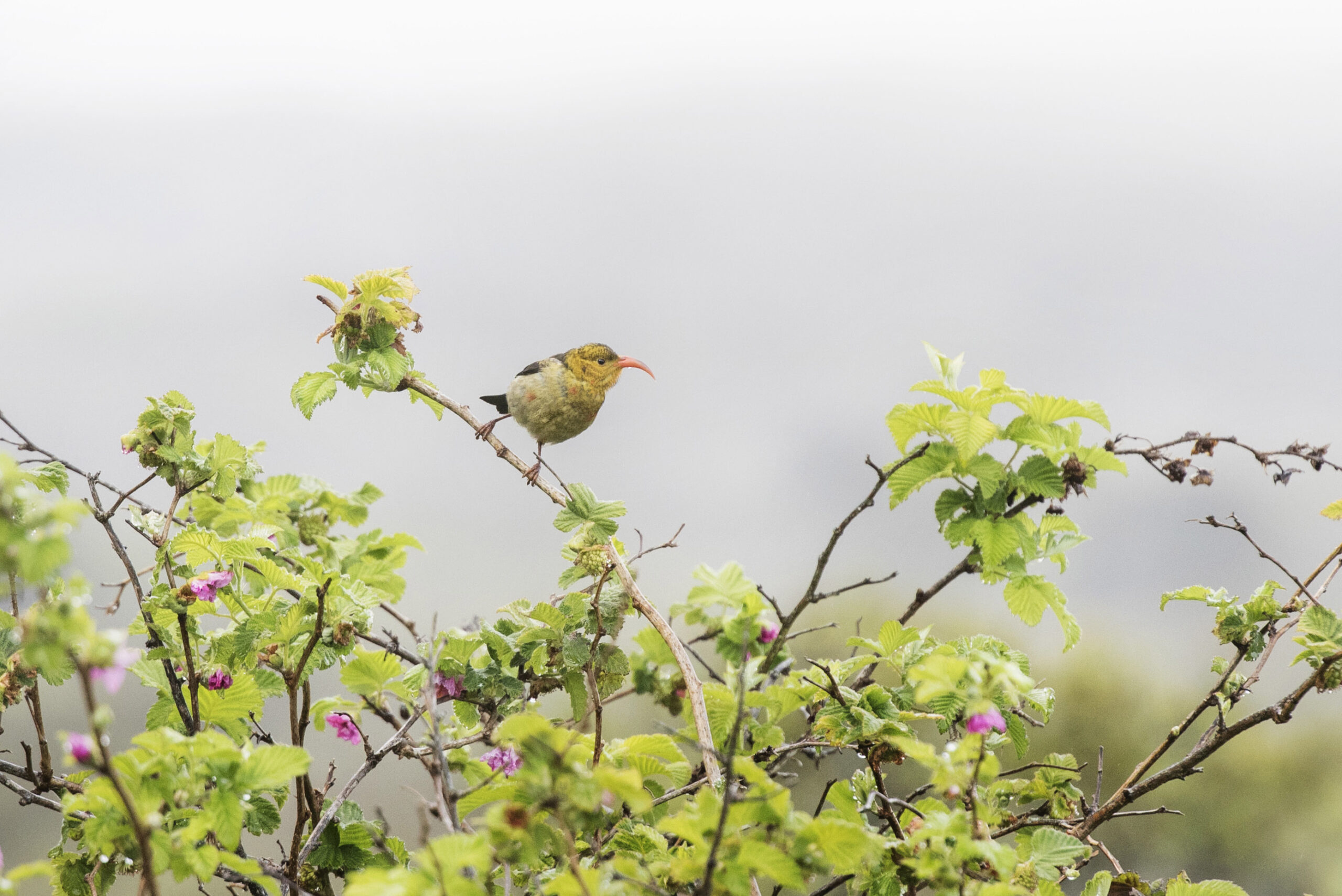Maui: A Birdwatcher’s Paradise

Like all of the Hawaiian Islands, Maui is a bird lovers’ paradise. Haleakalā National Park and the Upcountry offers a birdwatching opportunity for every kind of tourist, from the most traditional to the most adventuresome. And among the most coveted of all is a glimpse of Hawaii’s famous feathered icon, the honeycreeper. Perhaps no bird on the Islands boasts a story quite as fascinating as the honeycreeper. While the name might suggest a single bird, one cannot identify the “typical” honeycreeper quite so easily. No less than 18 different species of honeycreeper inhabit the Hawaiian archipelago across a wide variety of habitats. In general, most possess bright plumage, range in size from 4 to 8 inches and sing like a canary. They are also are known primarily by their native Hawaiian names. From there, the similarities largely end. Some honeycreepers, like the red-breasted ‘Apapane, swoop through the upper canopy of the forests. Others, like the ‘Akohekohe, forage in the understorey. Some, like the Maui Parrotbill, sport short bills to feast on bugs and seeds. Others, like the black-feathered Mamo, boast elegantly curved bills more suitable for drinking nectar. Even within species, the appearance of male and female birds sometimes differs drastically. Overall the variety is so great that scientists have classified honeycreepers into five genuses or “tribes:” Ciridops, Drepanis, Himatione, Melamprosops, and Palmeria.  So why all this variety? Originally, honeycreepers were believed to constitute their own family of birds. But recent DNA tests have revealed that the honeycreeper is actually a member of the finch and canary family. Within that family, the honeycreepers’ closest relative is the Eurasian Rosefinch—a bird found thousands of miles away, between Iran and Indochina. (Interestingly, honeycreepers are also related to North American birds such as the House Finch, which our guests may have seen at their home feeders.) Isolation, it turns out, has played a large role in the development of variety. Because honeycreepers on Maui had so little contact with these relatives on mainland Asia and North America, or even with their neighbors on other Hawaiian Islands, they each developed in their own way. At one time, the Hawaiian archipelago boasted 56 distinctive species of honeycreeper. But all has not gone well in paradise. The arrival of avian diseases and predators from other continents, compounded by widespread habitat destruction, has left 38 of the original honeycreeper species extinct. Of the 18 remaining, a number are also endangered. Today, Skyline Hawaii is proud to help conserve these remaining species. Through charitable partnerships with organizations like Maui Cultural Lands and The Nature Conservancy, we are helping to ensure future generations of Maui residents and guests will enjoy the dazzling sight of honeycreepers for years to come.
So why all this variety? Originally, honeycreepers were believed to constitute their own family of birds. But recent DNA tests have revealed that the honeycreeper is actually a member of the finch and canary family. Within that family, the honeycreepers’ closest relative is the Eurasian Rosefinch—a bird found thousands of miles away, between Iran and Indochina. (Interestingly, honeycreepers are also related to North American birds such as the House Finch, which our guests may have seen at their home feeders.) Isolation, it turns out, has played a large role in the development of variety. Because honeycreepers on Maui had so little contact with these relatives on mainland Asia and North America, or even with their neighbors on other Hawaiian Islands, they each developed in their own way. At one time, the Hawaiian archipelago boasted 56 distinctive species of honeycreeper. But all has not gone well in paradise. The arrival of avian diseases and predators from other continents, compounded by widespread habitat destruction, has left 38 of the original honeycreeper species extinct. Of the 18 remaining, a number are also endangered. Today, Skyline Hawaii is proud to help conserve these remaining species. Through charitable partnerships with organizations like Maui Cultural Lands and The Nature Conservancy, we are helping to ensure future generations of Maui residents and guests will enjoy the dazzling sight of honeycreepers for years to come.  Ready to add a few honeycreeper “feathers” in your birdwatching cap? Bring your binoculars along on one of our tours and keep your eyes peeled! On a light trail hike, the iconic ‘I’iwi might be spotted easily by a flash of its scarlet wings and crescent-shaped bill. Listen closely, and you also might hear what sounds like the buzzing of a miniature helicopter. Follow that rumble into a cluster of ōhiʻa lehua trees, and you could come face to face with the beautiful rust-red ‘A’papane. By contrast, spotting rarer gems such as Parrotbill and Akohekohe will require a bit more effort. Sighting these shyer (and more endangered) species usually requires special access to habitats that are normally restricted, like those found inside our neighboring Waikamoi Preserve. Plan ahead and make arrangements as necessary. Also, bear in mind that exploring less-traveled areas like Waikamoi requires enough stamina and athleticism for tougher hiking conditions. For those who truly want to glimpse a piece of authentic Hawaii, though, the extra effort could very well reward you with a rare sighting of these fast-vanishing treasures. There are no guarantees, of course. But the prospect alone is sweet, indeed. About the Author: Ready to break out your bird books and hit the trail? Skyline Hawaii is the proud operator of adventurous ecotours such as the Haleakalā National Park Tours. To learn more about our tours visit: www.skylinehawaii.com.
Ready to add a few honeycreeper “feathers” in your birdwatching cap? Bring your binoculars along on one of our tours and keep your eyes peeled! On a light trail hike, the iconic ‘I’iwi might be spotted easily by a flash of its scarlet wings and crescent-shaped bill. Listen closely, and you also might hear what sounds like the buzzing of a miniature helicopter. Follow that rumble into a cluster of ōhiʻa lehua trees, and you could come face to face with the beautiful rust-red ‘A’papane. By contrast, spotting rarer gems such as Parrotbill and Akohekohe will require a bit more effort. Sighting these shyer (and more endangered) species usually requires special access to habitats that are normally restricted, like those found inside our neighboring Waikamoi Preserve. Plan ahead and make arrangements as necessary. Also, bear in mind that exploring less-traveled areas like Waikamoi requires enough stamina and athleticism for tougher hiking conditions. For those who truly want to glimpse a piece of authentic Hawaii, though, the extra effort could very well reward you with a rare sighting of these fast-vanishing treasures. There are no guarantees, of course. But the prospect alone is sweet, indeed. About the Author: Ready to break out your bird books and hit the trail? Skyline Hawaii is the proud operator of adventurous ecotours such as the Haleakalā National Park Tours. To learn more about our tours visit: www.skylinehawaii.com. 
 So why all this variety? Originally, honeycreepers were believed to constitute their own family of birds. But recent DNA tests have revealed that the honeycreeper is actually a member of the finch and canary family. Within that family, the honeycreepers’ closest relative is the Eurasian Rosefinch—a bird found thousands of miles away, between Iran and Indochina. (Interestingly, honeycreepers are also related to North American birds such as the House Finch, which our guests may have seen at their home feeders.) Isolation, it turns out, has played a large role in the development of variety. Because honeycreepers on Maui had so little contact with these relatives on mainland Asia and North America, or even with their neighbors on other Hawaiian Islands, they each developed in their own way. At one time, the Hawaiian archipelago boasted 56 distinctive species of honeycreeper. But all has not gone well in paradise. The arrival of avian diseases and predators from other continents, compounded by widespread habitat destruction, has left 38 of the original honeycreeper species extinct. Of the 18 remaining, a number are also endangered. Today, Skyline Hawaii is proud to help conserve these remaining species. Through charitable partnerships with organizations like Maui Cultural Lands and The Nature Conservancy, we are helping to ensure future generations of Maui residents and guests will enjoy the dazzling sight of honeycreepers for years to come.
So why all this variety? Originally, honeycreepers were believed to constitute their own family of birds. But recent DNA tests have revealed that the honeycreeper is actually a member of the finch and canary family. Within that family, the honeycreepers’ closest relative is the Eurasian Rosefinch—a bird found thousands of miles away, between Iran and Indochina. (Interestingly, honeycreepers are also related to North American birds such as the House Finch, which our guests may have seen at their home feeders.) Isolation, it turns out, has played a large role in the development of variety. Because honeycreepers on Maui had so little contact with these relatives on mainland Asia and North America, or even with their neighbors on other Hawaiian Islands, they each developed in their own way. At one time, the Hawaiian archipelago boasted 56 distinctive species of honeycreeper. But all has not gone well in paradise. The arrival of avian diseases and predators from other continents, compounded by widespread habitat destruction, has left 38 of the original honeycreeper species extinct. Of the 18 remaining, a number are also endangered. Today, Skyline Hawaii is proud to help conserve these remaining species. Through charitable partnerships with organizations like Maui Cultural Lands and The Nature Conservancy, we are helping to ensure future generations of Maui residents and guests will enjoy the dazzling sight of honeycreepers for years to come.  Ready to add a few honeycreeper “feathers” in your birdwatching cap? Bring your binoculars along on one of our tours and keep your eyes peeled! On a light trail hike, the iconic ‘I’iwi might be spotted easily by a flash of its scarlet wings and crescent-shaped bill. Listen closely, and you also might hear what sounds like the buzzing of a miniature helicopter. Follow that rumble into a cluster of ōhiʻa lehua trees, and you could come face to face with the beautiful rust-red ‘A’papane. By contrast, spotting rarer gems such as Parrotbill and Akohekohe will require a bit more effort. Sighting these shyer (and more endangered) species usually requires special access to habitats that are normally restricted, like those found inside our neighboring Waikamoi Preserve. Plan ahead and make arrangements as necessary. Also, bear in mind that exploring less-traveled areas like Waikamoi requires enough stamina and athleticism for tougher hiking conditions. For those who truly want to glimpse a piece of authentic Hawaii, though, the extra effort could very well reward you with a rare sighting of these fast-vanishing treasures. There are no guarantees, of course. But the prospect alone is sweet, indeed. About the Author: Ready to break out your bird books and hit the trail? Skyline Hawaii is the proud operator of adventurous ecotours such as the Haleakalā National Park Tours. To learn more about our tours visit: www.skylinehawaii.com.
Ready to add a few honeycreeper “feathers” in your birdwatching cap? Bring your binoculars along on one of our tours and keep your eyes peeled! On a light trail hike, the iconic ‘I’iwi might be spotted easily by a flash of its scarlet wings and crescent-shaped bill. Listen closely, and you also might hear what sounds like the buzzing of a miniature helicopter. Follow that rumble into a cluster of ōhiʻa lehua trees, and you could come face to face with the beautiful rust-red ‘A’papane. By contrast, spotting rarer gems such as Parrotbill and Akohekohe will require a bit more effort. Sighting these shyer (and more endangered) species usually requires special access to habitats that are normally restricted, like those found inside our neighboring Waikamoi Preserve. Plan ahead and make arrangements as necessary. Also, bear in mind that exploring less-traveled areas like Waikamoi requires enough stamina and athleticism for tougher hiking conditions. For those who truly want to glimpse a piece of authentic Hawaii, though, the extra effort could very well reward you with a rare sighting of these fast-vanishing treasures. There are no guarantees, of course. But the prospect alone is sweet, indeed. About the Author: Ready to break out your bird books and hit the trail? Skyline Hawaii is the proud operator of adventurous ecotours such as the Haleakalā National Park Tours. To learn more about our tours visit: www.skylinehawaii.com. 